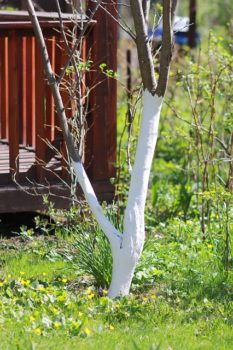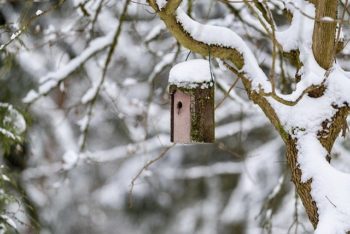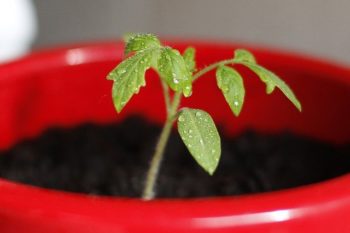Russian dachniki in February Posted by bota on Feb 22, 2021 in Culture, Russian life, when in Russia
Да́чный сезо́н на но́су! [lit. “the season of dachas is on the nose”, meaning “the season of dachas is almost here!”] The final week of February is a busy time for many Russian gardeners or those who have a “да́ча” (dacha or a country house). More on the history of dachas here.
Here are some things да́чники в России (Russian dachniki) might be up to this week:
Whitewashing the trees.
Побе́лка дере́вьев [pobelka derev’yev] is a common practice among Russian gardeners. They make a mix of equal parts interior latex paint and water that goes on the stem of both young and older tree (де́рево [derevo]) to protect its bark from sunburns. Tree bark damaged by sun is likely to split and attract pests and diseases, which is the last thing a gardener wants.
Snow blankets (сне́жные одея́ла[snezhniye odeyala]).
Many gardeners shovel snow from the road and garden paths onto perennials, above tree roots, and on top of the mulch of some snow-loving plants to keep them warm. Apparently, roses (ро́зы), grapes (виногра́д), and wild strawberries (земляни́ка) love these snow blankets and benefit from having the ground temperature warmer by a few degrees. Likewise, those with an orchard or a few trees gently shake the snow off the tree branches that might snap under the heavy weight. Their fruit trees (фрукто́вые дере́вья [fruktoviye derev’ya]) will thank them later.
Helping the birds.
Сини́ца(great tit) and воробе́й(house sparrow) are the two most common dacha guests (го́сти) across Russia. Therefore, many dacha owners clean and prepare bird houses (скворе́чники) and feeders (корму́шки) for the birds. Some Russians also recommend hanging са́ло (salo or cured pork fat), but I found many opposing views on whether the fat has to be salty or not, so maybe a safer option can be leaving little suet blocks (raw hard fat). In general, putting out some seeds (семена́) and bread (хле́б) is a pretty safe option.
Inventory of seeds and tools.
This one might seem easy but anyone who has every started a garden knows that thorough planning and inventory can go a long way (unless you like to have double the tomatoes planted compared to the tomato cages in your shed). Many Russians take this last week of February to go over their garden tools and the seeds they have for planting. I know seed libraries are great community resources in the US, but I haven’t heard of any library seeds in Russia except for some online seed exchanges. If you know of any, let me know in the comments.
Growing seedlings.
Lastly and most importantly, Russian gardeners are busy starting seeds for tomatoes (помидо́ры), onions (лук), peppers (пе́рец), eggplant (баклажа́ны) and some flowers (цветы́).
As the saying goes “Весна́ красна́ цвета́ми, а о́сень пирога́ми” [lit. Spring is beautiful for its flowers and fall for its pies], so happy gardening!

Build vocabulary, practice pronunciation, and more with Transparent Language Online. Available anytime, anywhere, on any device.






